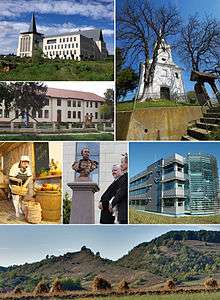Corunca
Corunca (Hungarian: Koronka, Hungarian pronunciation: [koronkɒ]) is a commune in Mureș County, Romania. It lies in the heart of Transylvania.
Corunca Koronka | |
|---|---|
 | |
 Location in Mureș County | |
 Corunca Location in Romania | |
| Coordinates: 46°31′N 24°37′E | |
| Country | |
| County | Mureș |
| Government | |
| • Mayor | Márton Nagy (UDMR) |
| Population (2011)[1] | 2,785 |
| Time zone | EET/EEST (UTC+2/+3) |
| Postal code | 547363 |
| Area code | +40 265 |
| Vehicle reg. | MS |
| Website | www |
Component villages
Corunca became an independent commune when the component villages split from Livezeni in 2004. The commune is composed of two villages:
| In Romanian | In Hungarian |
|---|---|
| Bozeni | Székelybós |
| Corunca | Koronka |
History
The area where the commune lies was inhabited even in ancient times. On the outskirts of the villages, remains were found from prehistoric and Roman times. The name of the present-day commune was first recorded in 1332 as Korunka.[2] In the vicinity, there used to be two other villages, Sárvári was destroyed in the 16th century while Kisernye was devastated in 1661 by Ottoman Turkish troops.
The village was historically part of the Székely Land in Transylvania and belonged to Marosszék in the Middle Ages. In the mid-1780s as part of the Josephine administrative reform, Marosszék was integrated into Küküllő county, however, the szék-system was restored in 1790. After the suppression of the Hungarian Revolution in 1849, the village formed part of the Székelykál military sub-division of the Marosvásárhely division in the Udvarhely military district.[3] Between 1861–1876, the former Marosszék was restored.[3][4] As a result of the administrative reform in 1876, the village fell within Maros-Torda County in the Kingdom of Hungary.[5] After the Treaty of Trianon of 1920, it became part of Romania and fell within Mureş-Turda County during the interwar period. In 1940, the second Vienna Award granted the Northern Transylvania to Hungary and the villages forming part again of Maros-Torda County were held by Hungary until 1944. After Soviet occupation, the Romanian administration returned and the village became officially part of Romania in 1947. Between 1952 and 1960, the commune fell within the Magyar Autonomous Region, between 1960 and 1968 the Mureș-Magyar Autonomous Region forming a commune like in the present day.[3] In 1968, the province was abolished,[6] and since then, the area fell in Mureș County while the villages were comprised by Livezeni wherefrom they split in 2004 to form an independent commune.
Demographics
In 1910, the two current component villages were inhabited by 963 Hungarians (82.87%), 103 Romanians (8.86%) and 91 Roma (7.83%). In 1930, the census indicated 1,107 Hungarians (85.75%), 164 Romanians (12.70%) and 17 Roma (1.32%).[7] In 2011, the population was composed as follows: 66.5% Hungarians, 30% Romanians and 3.2% Roma.[8]
| Year | 1850 | 1880 | 1900 | 1910 | 1930 | 1956 | 1977 | 1992 | 2002 | 2011 |
|---|---|---|---|---|---|---|---|---|---|---|
| Population | 927 | 911 | 1,223 | 1,162 | 1,291 | 1,562 | 1,918 | 1,627 | 1,743 | 2,785 |
References
- "Populaţia stabilă pe judeţe, municipii, oraşe şi localităti componenete la RPL_2011" (in Romanian). National Institute of Statistics. Retrieved 4 February 2014.
- János András Vistai. "Tekintő – Erdélyi Helynévkönyv" (PDF) (in Hungarian). p. 637. Archived from the original (PDF) on 10 October 2007. (Transylvanian Toponym Book)
- Tibor Elekes. "Marosvásárhely közigazgatási szerepe a XIV. századtól napjainkig" (PDF) (in Hungarian). p. 2.
- Gazetteer of Hungary, 1873 Archived 29 October 2008 at the Wayback Machine
- Hungarian Administrative Reform Act 1876
- James F. Brown (2001). The grooves of change: Eastern Europe at the turn of the millennium. Duke University Press. p. 54. Retrieved 10 February 2015.
Mureş-Magyar Autonomous Region 1968.
- Árpád E. Varga. "Etnikai statisztikák" (PDF) (in Hungarian). Pro-Print Kiadó. Retrieved 21 August 2010.
- (in Romanian) Populaţia stabilă după etnie - judeţe, municipii, oraşe, comune, National Institute of Statistics; accessed August 26, 2015
